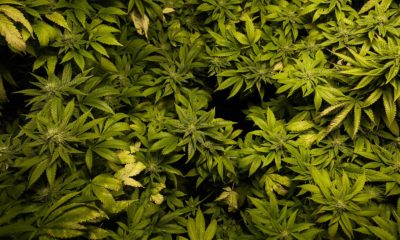
Science
Everything You Need to Know About the Science Behind Cannabinoids
Get to know the three different classes of cannabinoids: phytocannabinoids, endocannabinoids and synthetic cannabinoids.
The cannabis plant produces literally hundreds of specialized molecules — cannabinoids, terpenes and flavonoids — that have been shown to deliver medicinal efficacy, lifestyle enhancement and even performance enhancement to human beings. For those afflicted with disease, medical cannabis has been found to offer a wide range of health benefits, from killing cancerous tumors to alleviating the pain of arthritis to reducing the number of seizures experienced by epileptic children.
Of these molecules, cannabinoids are the most cited and understood. The most infamous cannabinoid is tetrahydrocannabinol (THC), the molecule responsible for most of the psychoactive (psychotropic) and euphoric effects of cannabis, but that also has been found to successfully treat serious conditions, such as PTSD and cancer. Another notable cannabinoid is cannabidiol (CBD), a mostly non-psychoactive chemical that has been found to provide a wide range of medicinal benefits, including reductions in pain, anxiety and depression.
Endocannabinoids vs. Phytocannabinoids
First discovered in 1964 by Israeli researcher Raphael Mechoulam, phytocannabinoids from the cannabis plant interact with the human body by mimicking the molecular characteristics of chemicals produced internally. Called endocannabinoids, these internally manufactured molecules include anandamide and 2-AG.
Anandamide has been dubbed the “bliss molecule” because of its ability to decrease depression in humans. It plays a central role in the regulation and modulation of critical bodily functions such as mood, appetite, sleep, immune system efficiency and one’s ability to deal with stress and anxiety.
Synthetic Cannabinoids
Synthetic cannabinoids emerged in the 1970s and are created in a laboratory. An example of it would be dronabinol (Δ9-THC synthetic), which is the active compound of Marinol, a medicine that comes in capsules and has been consumed in the US since 1985 to prevent nausea, vomiting, loss of appetite and loss of weight.
The Endocannabinoid System
All mammals, not merely humans, have evolved with a network of specialized cellular receptors throughout their bodies that are designed to bind with cannabinoids — both endocannabinoids such as anandamide and phytocannabinoids from cannabis — that is called the endocannabinoid system (ECS).
The fact that the ECS is present in all mammals is why companies and product lines dedicated to the health and wellness of household pets are beginning to emerge in legal cannabis markets. Dogs and cats suffering conditions such as arthritis, digestive issues, anxiety and pain can gain significant benefit from the cannabinoids in cannabis and hemp.
Anandamide production has been found to increase and temporarily spike in those who engage in endurance exercise on a regular basis. However, it metabolizes quickly, exhibiting a relatively short duration of effect. Anandamide hints at the chemical underpinnings of the significant health benefits of frequent and intense exercise—and the fact that the mere consumption of cannabinoids is not enough to establish and sustain optimal health of the ECS (a condition called homeostasis that means “balance”).
Both internally produced endocannabinoids and plant-based phytocannabinoids interface with the ECS via specialized cellular receptors that were discovered in the 1990s and called CB1 and CB2. CB1 receptors are found mostly in the brain and central nervous system, whereas CB2 receptors are located primarily in the organs and tissues of the immune system—including the thymus, skin, bone marrow, lymph nodes, spleen, bowel and the mucous membranes of the bladder, genitals, nose and throat.
Major Cannabinoids + Acidic Precursors
More than 113 cannabinoids have been isolated and identified within the cannabis plant — which is, technically, also a vegetable. Beyond the two major cannabis-derived molecules, THC and CBD, are a plethora of healthful cannabinoids that deliver a slew of desirable and beneficial efficacies for lifestyle consumers and patients alike. Among these are cannabichromene (CBC), cannabigerol (CBG), cannabinol (CBN) and tetrahydrocannabivarin (THCV).
Additional healthful cannabinoids include tetrahydrocannabinolic acid (THCA) and cannabidiolic acid (CBDA). These chemicals represent a class of cannabinoids dubbed acidic precursors. Think of acidic precursors as the larval caterpillar stage of what becomes the butterflies of THC and CBD.
While they provide significant benefits in terms of health and wellness, the exact effects of these molecules differ from their non-acidic versions. For example, while strains of cannabis that are potent in THC can exact a significant toll in terms of psychoactivity and euphoria, THCA delivers no such psychotropic effect. THCA does, however, offer anti-inflammatory and neuroprotective effects, making it helpful for conditions as wide-ranging as Alzheimer’s disease, arthritis, cancer, Crohn’s disease, fibromyalgia, multiple sclerosis and Parkinson’s.
Understanding Decarboxylation
The process by which the transmogrification from the chemical state of acidic precursor (THCA) to its child molecule (THC) occurs is significant (and can be accurately controlled by anyone). A process called decarboxylation, this conversion involves the application of heat (via flame, as in combustion, or from a hot surface or airstream, as in vaporization) to catalyze a chemical reaction in which the THCA molecule drops a carbon and two oxygen atoms (called a carboxyl ring, or COOH) to become THC — and gain its euphoric effects based on its newfound binding affinity with the CB1 receptors of the ECS.
Technically, maximum decarboxylation for a sample of cannabis flowers occurs most effectively when exposed to 220 degrees F (104 degrees C) for a period of 30 to 45 minutes. Decarboxylation is easy and convenient because it can be accomplished using a standard consumer oven.
Thus, one who eats the raw flowers of cannabis will gain significant medicinal benefits, but no euphoria. The simple application of a flame or hot air, however, leads to the nearly instantaneous transformation of these molecules into their chemical cousins, delivering beneficial — but sometimes very different — effects.
The Research
A 2017 research study entitled “Medicinal Cannabis: History, Pharmacology and Implications for the Acute Care Setting” that was published in the journal Pharmacy & Therapeutics found the cannabinoids of cannabis, such as THC and CBD, to be effective in the treatment of a wide range of diseases and conditions.
The study’s researchers stated, the “Beneficial cannabinoids exist, as evidenced by single-entity agents derived from cannabis containing the compounds THC and CBD.” The study concluded that “cannabis is relatively safe; therapy is self-titratable by the patient; and…therapy is relatively inexpensive compared with pharmaceutical agents.”
CBC is a powerful cannabinoid first isolated in 1964 by Israeli researcher Raphael Mechoulam. It is considered one of the “big six” cannabinoids that, according to Steep Hill Labs in Berkeley, California, is ten times more effective than CBD in treating anxiety and stress.
In a 2011 study conducted by cannabis research pioneer Ethan Russo entitled “Taming THC: Potential Cannabis Synergy and Phytocannabinoid-terpenoid Entourage Effects” and published in the British Journal of Pharmacology, Russo found that a CBC-extract displayed “pronounced antidepressant effect,” meaning it may be helpful for humans suffering from anxiety and depression.
Additional evidence of the medical benefits of cannabinoids derived from cannabis — this time for an ocular disease — was revealed in a 2008 study entitled “Possibilities of Applying Cannabinoids in the Treatment of Glaucoma” that was published in the journal Klinika Oczna. The study concluded that cannabinoids like CBG are “able to decrease intraocular pressure. These compounds are characterized by neuroprotection and vasodilatation properties that additionally substantiate their therapeutic utility in conservative treatment of glaucoma.”
Originally published on cannabisaficionado.com.

























